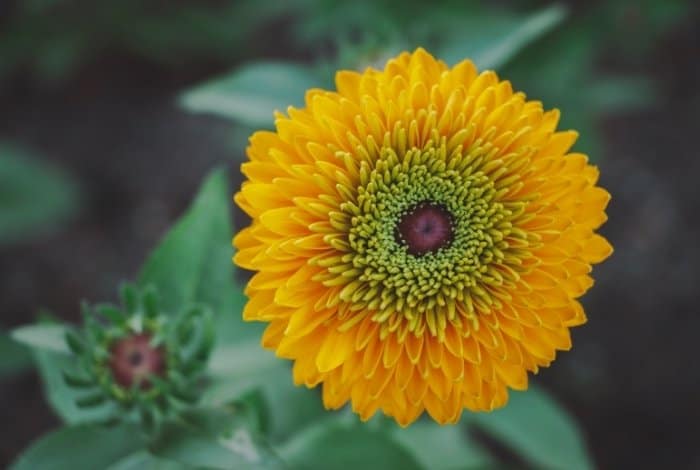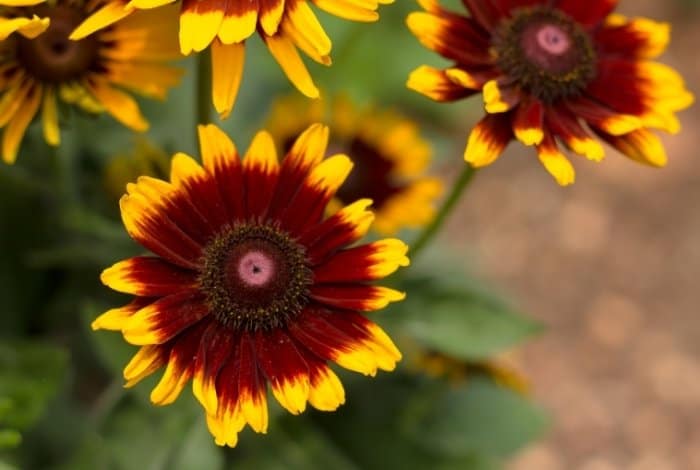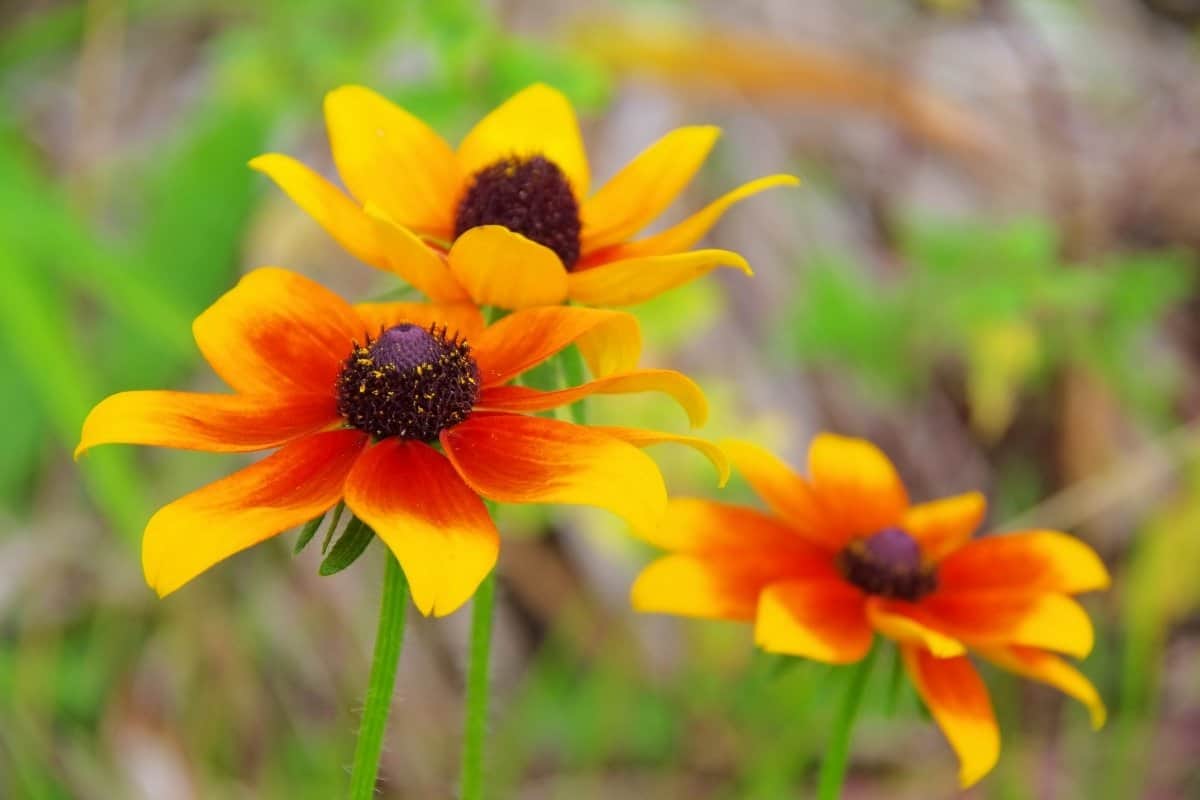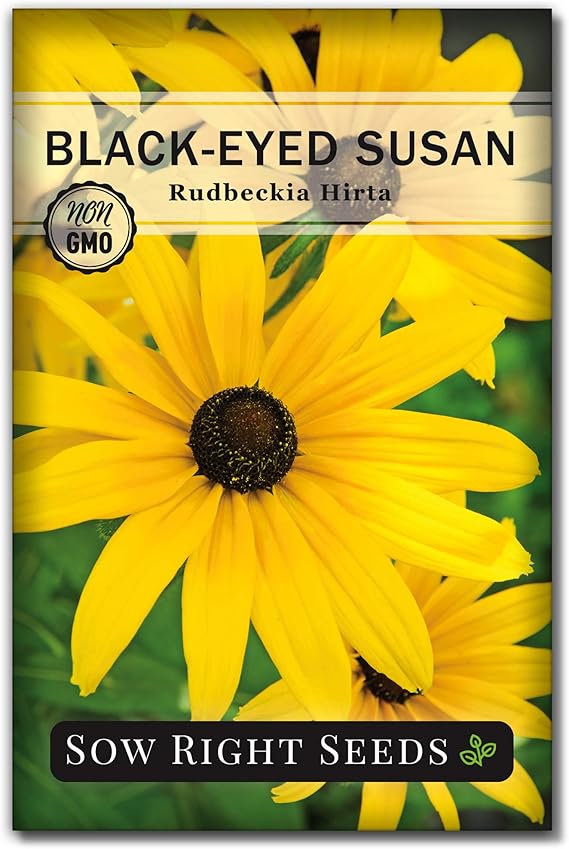Last Updated on January 20, 2022 by
When do black-eyed Susans bloom and how long their blooms do last are questions that most gardeners seek for answers without finding.
Black-eyed Susans (Rudbeckia hirta ) is named that because of her dark central cone that is surrounded by brightly colored petal-like rays. They are native to North America and one of the most popular grown wildflowers. They are a breathtaking beauty covering most open fields and presenting such beauty to anyone passing by.
Members of the Aster family, the Asteraceae or the black eye is named for the brown-purple or dark centers of its daisy-like flower heads. These plants grow to over 3 feet tall with 6-inch leaves, 8 inches long stalks, and 2 to 3 inches flower diameter. The flowers attract bees, butterflies, and a variety of insects for the nectar. As they take the nectar, they move the pollen from one plant to another making them from fruits and seeds that move easily with the wind.
When Do Black-Eyed Susans Bloom?
Black-eyed Susans bloom in different seasons depending on if the plant is annual or a perennial.
The annuals bloom throughout summer and die during winter. The cycle begins again in spring with the seeds germinating and continues to bloom in summer. The annuals include varieties like Clasping Sunflower (Rudbeckia amplexicaulis)
Other varieties are biennial meaning they germinate in spring but flower in the second year. But if you can plant the same seeds of this variety indoors about 6 weeks before the last frost date, you will be rewarded with flowers within the first year. This variety includes the familiar roadside black-eyed Susans (Rudbeckia hirta).
While it may flower in the first year, you cannot count on this plant to flower every year so enjoy it when it happens.
The perennials include Sweet Black-eyed Susans (Rudbeckia subtomentosa) available in seeds or the cultivars of Goldstrum (Rudbeckia fulgida ‘Goldstrum). These flowers will return every year to light up your fall garden.
To extend your flowering period, pinch off the spent blooms at the base of the stem. You can also cut back the stem of the black-eyed Susans after they flower.
This encourages a second surge of blooms later in the fall. Pinching, also known as deadheading which not only encourages more blooms but a sturdy compact plant.
Find more Tips by Clicking here:
Types Of Black Eyed Susans
Autumn Colors Black-eyed Susan (Rudbeckia)
‘Autumn colors’ is a breathtaking beauty that bears 5-inch wide gold flowers with traces of red, rust, and bronze. It grows up to 2 feet.
Brown-eyed Susan (Rudbeckia Triloba)
This is a North American native biennial that has clusters of small yellow flowers in autumn and summer. This variety grows up to 5 feet tall and 3 feet wide. It does best in zones 4-7 across the United States.
Black Eyed Susan Flower Seeds for Planting
Goldstrum Black-eyed Susan (Rudbeckia Fulgida Var. Sullivantii ‘Goldsturm’)
This is one of the popular perennials of all time. It produces bright yellow daisies that are accented with a dark brown cone. These daisies are 3 to 4 inches in diameter and bloom from mid-summer to fall. It grows up to 2 feet tall in hardy zones that are 4-9.
Indian Summer Black-eyed Susan (Rudbeckia Hirta)
Indian summer produces bright golden flowers and hairy foliage that grows up to 3 feet tall. It blooms from summer to frost and thrives in zones 3-7. This variety commonly grows as annuals.
Maya Black-eyed Susan (Rudbeckia)
This is an annual dwarf variety with golden yellow double flowers that grows up to 18 inches tall.

Prairie Sun Black-eyed Susan (Rudbeckia Hirta)
This variety produces yellow-orange flowers from summer to frost. It is hardy and grows in zones 3-8 as an annual.
Radiance Black-eyed Susan (Rudbeckia)
Radiance is annual and produces distinct double flowers with quilled petals.
It grows up to 18 inches tall.
Sonora Black-eyed Susan (Rudbeckia)
This is an annual with large mahogany petals tipped in yellow that grows up to 20 inches tall.

Toto Lemon Black-eyes Susan (Rudbeckia)
This is a dwarf variety with cheery bright yellow blooms that come out in summer.
This type grows up to 15 inches tall.
Toto Rustic Black-eyed Susan (Rudbeckia)
This is an annual type that produces golden blooms with a rich burgundy-red center and grows up to 15 inches tall.
FAQs
Do Black Eyed Susan come back every year?
The answer is yes, yes they do.
Black-eyed Susans (Rudbeckia hirta) are well known for blooming in mid to late summer.
How do you make Black Eyed Susans bloom?
They start in the spring and go all the way through fall. They prefer full sun to partial shade and have deep taproots that help them survive drought conditions.
The answer is in the soil, which is a combination of organic matter, sand, clay and humus. The Black Eyed Susan plant will not bloom well if it has any one of these things lacking or if it’s sandy, or if the topsoil is compacted.
So how do you get it? You must start with a deep, rich soil. You can start with compost but it’s best to use the old stuff that you don’t want anymore.
Do Black Eyed Susans flower the first year?
Black-eyed susans don't flower until the second year.
What do you do with Black Eyed Susans at the end of the season?
You put them in a big vase and take them home to your garden. Or, as my dad used to say: "You put them in a bucket, bring them inside, and water them." The flowers have to be in water for about a week. Then they can go back out to the garden.
The stems die down after flowering and the flowers die off.
Do you cut back black-eyed Susans?
I have a lot of black-eyed Susans in my garden, but I don't cut them back because I want to keep the seedheads in the garden. But I do harvest the seeds to use in my cooking and eating.
Conclusion
FAQs
Do Black Eyed Susan come back every year?
The answer is yes, yes they do.
Black-eyed Susans (Rudbeckia hirta) are well known for blooming in mid to late summer.
How do you make Black Eyed Susans bloom?
They start in the spring and go all the way through fall. They prefer full sun to partial shade and have deep taproots that help them survive drought conditions.
The answer is in the soil, which is a combination of organic matter, sand, clay and humus. The Black Eyed Susan plant will not bloom well if it has any one of these things lacking or if it’s sandy, or if the topsoil is compacted.
So how do you get it? You must start with a deep, rich soil. You can start with compost but it’s best to use the old stuff that you don’t want anymore.
Do Black Eyed Susans flower the first year?
Black-eyed susans don't flower until the second year.
What do you do with Black Eyed Susans at the end of the season?
You put them in a big vase and take them home to your garden. Or, as my dad used to say: "You put them in a bucket, bring them inside, and water them." The flowers have to be in water for about a week. Then they can go back out to the garden.
The stems die down after flowering and the flowers die off.
Do you cut back black-eyed Susans?
I have a lot of black-eyed Susans in my garden, but I don't cut them back because I want to keep the seedheads in the garden. But I do harvest the seeds to use in my cooking and eating.
Are you looking for a pretty plant that is practically easy to grow and beautiful? Black-eyed Susans are some of the best cheerful flowers you will ever come across. They are simply hard to beat when it comes to their care and maintenance.
Now that we know when do black-eyed Susans bloom, go ahead and grow yours. Their big bloom is a beauty that most flowers do not provide. And if you choose these flowers, hummingbirds, butterflies, and bees will become your friends!
Caroline is a gardener who loves to get down to the nitty–gritty of gardening. She proudly proclaims herself as a ‘dirt worshipper‘ and can often be found deep in the garden, covered in soil and singing to her plants. As a self–proclaimed ‘plant whisperer‘, Caroline believes that plants need love and attention just like any other living thing, and she loves to give them both. When she‘s not tending to her garden, you can often find her researching the latest gardening trends, or teaching others how to make their gardens thrive



